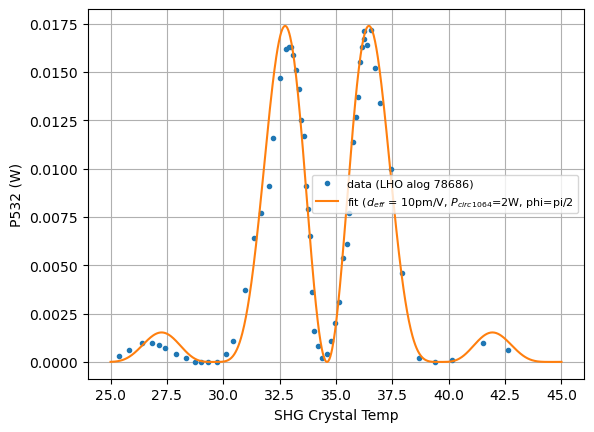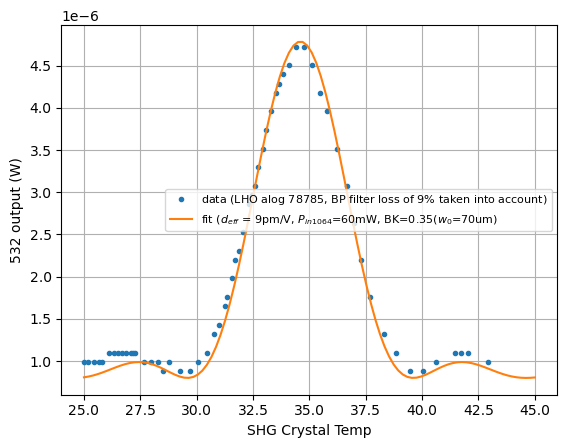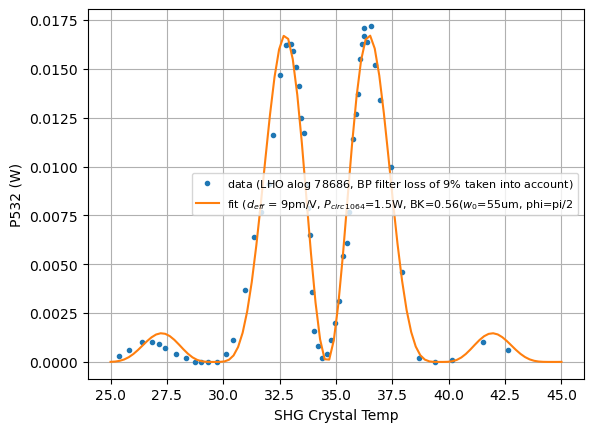Daniel, Nutsinee
I was intrigued by the Twin Sisters Rock feature in the brand new spare SHG Terry and Karmeng put together so I did a little bit of digging. A quick summary is that we believe the Twin Sisters Rock feature were caused by the phase mismatch between the red and the green inside of the SHG cavity. We believe the dichroic coating of the SHG back mirror might be a suspect since the coating specifications can not be found. However, the phase mismatch doesn't neccessary explain the Mount Saint Helens in the 6 year-old SHG we are currently using.

The equation used to fit the data came from Gonzalez, Nieh, and Steier 1973 equation1. The equation looks similar to the usual sinc^2 function we know and love except that it's taken the phase mismatch between 532 and 1064 and the air dispersion into account in the cos^2 term. This paper also shows that the experimental data doesn't necessary match the model (Fig.3). The problem is we have to related deltaK*l term to temperature. This was done using Kato and Takaoka 2002. This left us with K_0. The only unknown-ish term here is the nonlinear coefficient d_eff inside of K_0. We used d_eff = 10pm/V as suggested by Leonardi et al 2018. After I wasn't able to get a sensible result Daniel pointed out that unit in K_0 doesn't add up. We replaced K0 with equation1 from Arie et al 1997.
The function is also very sensitive to polling length of the crystal. Since we don't have the exact number of the polling length, we picked a polling length such that deltaK is 0 at 34.6 C (optimal phase match condition). The polling length we got was 8.99608um. I believe the crystal polling length according to Raicol is 9um.
The function in the end looks like this. I was able to fit Karmeng's Twin Sisters Rock using sensible parameters (d_eff = 10pm/V, circulated 1064 power of 2W, Boyed-Kleinman focusing parameter = 0.9, and a phase shift of Pi/2). Other variations of the spare SHG plots can be explained by shifting this phi variable.
We suspect the coating of the SHG back mirror might be to blame. None of the SHG plots found in SURF reports (Nathan Zhao, Andre Medina) look symmetric like they should.
The zip file of the python code is also attached.
If the coating is not to blame, I wonder if it's time we think about redesigning a SHG that is more tolerant to the assembly line errors.
For people who are too lazy to read the paper: The dispersion that matters is between the first path and the second path in the crystal. In a simple dual path system, green light will be generated in phase with the red light in the first path, then the two frequencies propagate in air towards the rear mirror, where they are reflected with potentially different phases, and then propagate back to the crystal. According to Gonzalez et al. the dispersion in air for 1064/532 is 27.4°/cm (double passed). Our SHG length is about 5 cm long with a 1 cm crystal. So, the in-air path is of order 4 cm. You need a 90° phase shift to explain the double peak. However, the phase difference of our mirror reflectivity is unknown.
Daniel Nutsinee

We futher fit a single pass measurements with following parameters:
d_eff = 9pm/V
input power = 60mW
Boyd-Klienman factor = 0.35 (corresponds to w0 = 70um according to Karmeng this is what he sent into the cavity)
The measured power was so low a dark noise is required to offset the model to fit the data correctly. This value is 0.8 uW.
A factor of 1/2 has been added inside of sinc and cos term to convert from double pass to single pass. This agrees with Sheila's equation 3.14.

We also added a factor of 4 to the original function used to fit the double peak measurement to take into account the double pass (4 times the single pass power). A newly acquired Boyd-Klienman factor is 0.56 (corresponds to w0 = 55um, a beam waist dictates by the known cavity parameters). I recalculated circulated power taken into account loss measurement from the escape efficiency. The model suggests 1.7W. I managed to fit using 1.5W. We don't know the modulation depth used to generate the locking signal so this number can be wiggled around a bit. The facator of 4 can also be wiggled around a bit as we don't really know the green loss as it emerges from the cavity.
According to Karmeng the data was taken through a green Bandpass filter with 9% green loss. The data has been multipled by a factor of 1.09 to compensate for this loss.
In summary, our model fits both the Twin Sisters and the single pass measurements.







